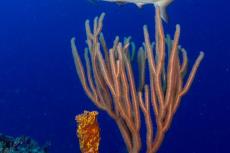Fire corals spreading on Caribbean reefs
Caribbean fire coral thrives when other corals die because of its unusual ability to grow in two forms.
Sessile organisms, such as corals where adults are immobile and their growth position is determined at settlement, are confronted by unique circumstances arising in that particular location.
In some habitats, anthropogenic effects are causing large changes in community structure, as well as the environmental conditions to which they are exposed. On a densely populated reef space is a limited resource. One of the ways organisms can win that space is through the strategy of shape.
Every year for the past three decades, California State University, Northridge marine biologist Peter Edmunds has travelled to the Caribbean island of St. John in the U.S. Virgin Islands to document the life history of fire corals.
Two forms make a winner
In the battle over the limited space on the shallow reefs, Edmunds has found that fire corals — with their ability to grow as sheets or as trees — are the winners. "They have a strategy that allows them to spread when they can and allows them to produce branches when they can,” he said.
Delicately branched colonies occur in calm water, sturdily branched colonies in turbulent conditions and encrusting sheets are found at sites with the roughest conditions and turbid water. These trends help to explain why Millepora spp. can spatially dominate in shallow and rough conditions.
Fact file
Fire corals, Millepora spp., are hermatypic (reef-building) corals that are globally distributed and represented by 16 species.
Millepora spp. are hydrozoans with pores instead of corallites in which polyps are located, and they produce medusae asexually, which then release sexual gametes soon after emergence.
Millepora spp. produce morphologically complex colonies with sheets spreading across the substratum and upright trees having a diversity of shapes and sizes.
















































